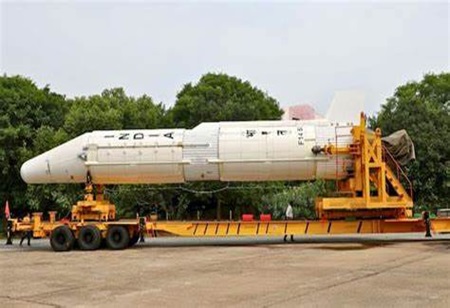
ISRO Prepares to Launch INSAT-3DS Weather Satellite

 In a momentous achievement in space exploration, the Indian Space Research Organization (ISRO) has successfully launched the GSLV-F14 rocket from Sriharikota on February 17, 2024. This mission marked a significant leap forward with the flawless deployment of the INSAT-3DS meteorological satellite into Geosynchronous Transfer Orbit (GTO). Conducted in collaboration with the Ministry of Earth Sciences (MoES), this endeavor signifies a notable advancement in meteorological monitoring and disaster alert systems, both domestically and internationally.
In a momentous achievement in space exploration, the Indian Space Research Organization (ISRO) has successfully launched the GSLV-F14 rocket from Sriharikota on February 17, 2024. This mission marked a significant leap forward with the flawless deployment of the INSAT-3DS meteorological satellite into Geosynchronous Transfer Orbit (GTO). Conducted in collaboration with the Ministry of Earth Sciences (MoES), this endeavor signifies a notable advancement in meteorological monitoring and disaster alert systems, both domestically and internationally.
With the GSLV-F14 embarking on its 16th mission and its 10th flight utilizing the indigenous cryogenic engine, ISRO has demonstrated not only its engineering excellence but also its steadfast commitment to enhancing Earth observation capabilities. The INSAT-3DS, replacing its predecessors INSAT-3D and INSAT-3DR, is poised to revolutionize weather monitoring, funded entirely by the Ministry of Earth Sciences. This underscores India's dedication to leveraging space technology for terrestrial benefits, particularly in weather prediction and climate research. The successful deployment of INSAT-3DS sets a notable precedent for future missions, including the highly anticipated NISAR Earth observation satellite.
In a captivating blend of tradition and technology, ISRO's decision to avoid the number '13' in mission naming—opting for GSLV-F14—reflects a pattern observed in its Polar Satellite Launch Vehicle (PSLV) series. This choice resonates with superstitious tendencies globally, reminiscent of NASA's post-Apollo-13 incident avoidance of the number. Despite this cultural homage, ISRO's operations maintain scientific rigor, incorporating traditional practices such as coconut-breaking ceremonies and prayers at the Lord Venkateswara Temple in Tirumala, believed to complement scientific endeavors. ISRO's launch determinations remain rooted in scientific considerations, ensuring optimal planetary positioning and precise spacecraft orbit insertion.
As the INSAT-3DS satellite embarks on its mission to deliver advanced weather observations, it not only surpasses its predecessors but also sets the stage for future advancements in meteorological studies and disaster management. The GSLV-F14/INSAT-3DS mission, blending cutting-edge technology with respect for cultural traditions, exemplifies India's confident stride towards the forefront of global space exploration. This mission underscores the seamless integration of scientific excellence and cultural ethos, reflecting ISRO's vision for upcoming missions aimed at enhancing human understanding of Earth and fortifying its inhabitants against natural calamities.
In the vast realm of space exploration, the triumphant GSLV-F14 launch carrying the INSAT-3DS transcends mere accomplishment for ISRO; it symbolizes India's innovative spirit, technological prowess, and cultural essence. As INSAT-3DS gazes skyward, it stands as a testament to the boundless potential of human aspiration fueled by the synergistic forces of science and heritage.